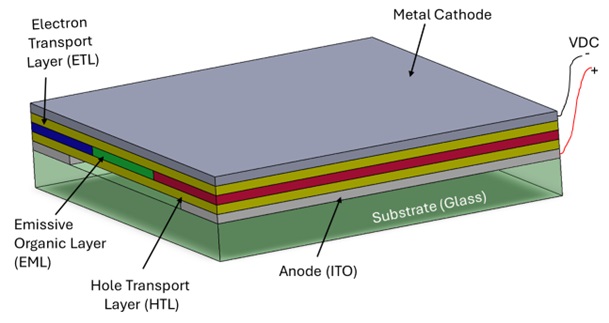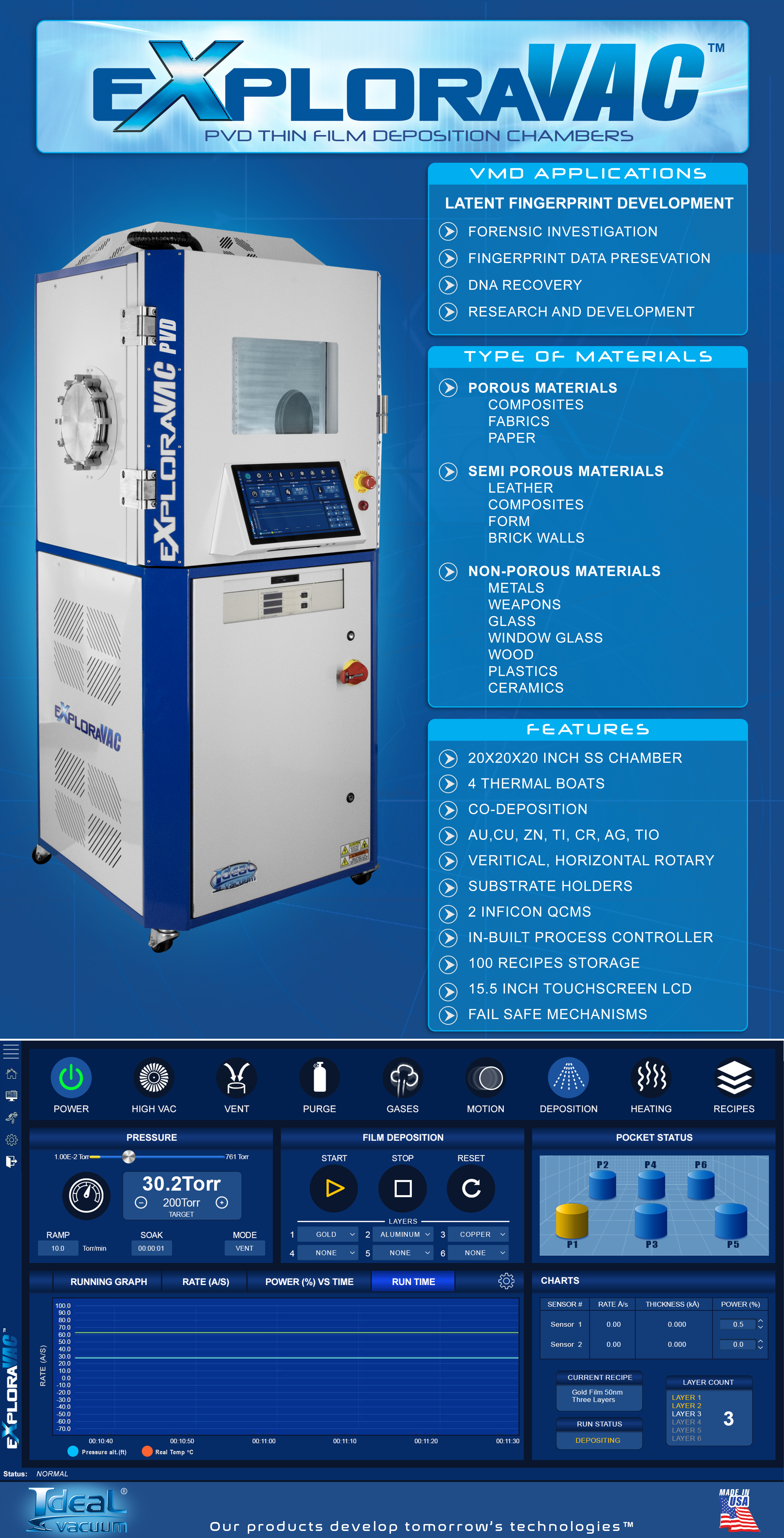This box vacuum coater system is designed for the vacuum low temperature evaporation and deposition of temperature sensitive organic and organometallic compounds in a laboratory environment. The chamber is 20 x 20 x 20 inches cubed in volume and is made of stainless steel. It has 6 thermal evaporation crucibles that have a loading capacity of 10 cc and a total volume of 15 cc. It is equipped with many features, including a custom made 6-inch rotary substrate holder. It has 2 Inficon QCM sensors, and an in-built Inficon STM-2 thickness controller with manual and auto process mode. There is a provision to add radiant heaters for the substrate holder if needed. The deposition process can be sequential or co-deposition. Other features are 2 reactive deposition gas inlet ports, door viewport with gravity shutter and chamber lighting to observe coating progress, pneumatic source and substrate shutters, fail safe mechanisms, visual and audio status indicators in form of stack lights and alarms.
The system includes a built-in 15.5” touch screen display equipped with non-expiring basic version of AutoExplor™ software, run by an onboard Windows computer which can control all chamber and deposition process functions. All electronic components are UL certified for North America. The system is installed with direct apparent crucible coil power, voltage and load current measurement modules and display unit in the lower cabinet.
The system can vaporize common organic and organometallic materials like PMMA, AIQ3, CuPc, MAI, fullerene - C60, and perylene derivatives like PTCDA and PDI. A variety of organic based precursors for dielectric material deposition of SiO2, TiO2, Al2O3, GeO2 can be vaporized too.
The chamber is rough pumped by an Edwards nXDS20i dry scroll pump and fine pumped by Pfeiffer HiPace 300 turbo molecular pump to a base pressure of 3 x 10-7 Torr when properly conditioned. Prior to deposition, the crucibles can be heated to 100 °C to dry the samples. A cryopump is installed to trap moisture. Each ceramic crucible pocket is wrapped in a heating coil that has a PID temperature controller to make sure no overheating of sample occurs.
We can customize recipes for your VLTE processes. We thoroughly test run your processes before shipping. In-person or virtual training of the SOP is also provided upon request. Our system comes with a standard one-year warranty. The lead time is 90 days after the purchase order is confirmed.
ExploraVAC PVD VLTE Organic Thermal Evaporator:
- Fully Enclosed 20” Welded SS Vacuum Chamber with Interior Shields
- 6 Crucibles, 15.0 cc, 10 cc Load Capacity
- Crucible Temperature Range: 30 – 800 °C
- Compatible with Alumina, Zirconia, Tungsten, Graphite, Quartz Crucibles
- Rotary Substrate Holder (Custom)
- Pneumatic Shutters
- 2 QCM Sensors
- Substrate Radiant Heaters (Optional)
- Door with 6’’ Viewport with gravity shutter
- Quick-Latch Front Door Closure
- Through Viewport LED Chamber Lighting
- 15.5” LCD Touch Screen Display
- Edwards nXDS20i Dry Scroll Vacuum Pump
- Pfeiffer HiPace 300 Turbo Pump
- Apparent Crucible Coil Power Measurement and Display
- Maximum Coil Power - 160W
- PID Temperature Control for Each Crucible
- Visual and Audio Run Status Indicators
- Fail Safe Mechanisms
PVD Thermal Evaporation Deposition Overview
Figure 1. Schematic diagram of thermal evaporation of target material in a boat during a PVD process.
Thermal evaporation Physical Vapor Deposition (PVD) is a simple method used to deposit thin films of material onto substrates in a vacuum environment. Both metallic and non-metallic films can be deposited by this method. During the deposition process, a material is thermally heated until it melts and vaporizes, and then the vapor lifts off and condenses onto a cooler substrate, forming a thin film. Some materials like Cr simply sublimes without melting, achieving the optimum deposition vapor pressure. The mean free path of the vapor molecules must be long enough to avoid collisions with residual gases in the chamber. This is achieved by ensuring the base pressure falls below a calculated threshold before initiating evaporation.
Our chambers are fine pumped by Pfeiffer HiPace turbo molecular pumps to below 10-7 Torr within a few minutes, at this gas pressure, the mean free path of the vapor is increased to beyond 40 inches which is about four times greater than the deposition process throw distance. This ensures efficient and contamination-free deposition of our systems. A QCM sensor is a common film thickness monitor incorporated into PVD chambers to constantly give feedback on rate of deposition and film thickness.
Principle of VLTE for Organic Materials Deposition
Vacuum low thermal evaporation (VLTE) is a method used to deposit thin films of materials onto substrates under vacuum conditions at relatively low temperatures. The source material is heated just enough to evaporate without decomposing or reacting. When it comes to organic materials, this technique is particularly useful because many organic compounds are sensitive to high temperatures and can degrade if exposed to too much heat. In VLTE, the material to be deposited is heated in a crucible under vacuum until it evaporates or sublimes. The material is not in direct contact with the heating element as is the case in conventional thermal evaporation. The vacuum environment reduces the boiling point of the material, allowing it to evaporate at a lower temperature. This vapor then condenses on the substrate, forming a thin film. For organic materials, this process is carefully controlled to prevent decomposition and ensure a high-quality film. The operating temperature range of VTLE process goes up to about 800 °C, above which most thermally stable organic compounds start to decompose changing the chemical structure of the film coating, leading to film defects.
Examples of VLTE Organic Based Thin Film Coating Materials
Figure 2. Aluminium tris(quinolin-8-olate) AlQ3
AlQ3 is a yellow powder with a melting point of 410 – 430 °C. AlQ3 is commonly used as an electron transport layer in OLEDs. It facilitates the transport of electrons from the cathode to the emissive layer. AlQ3 can also serve as an emissive layer material, where it emits light upon recombination of electrons and holes. It typically emits green light.
Figure 3. Perylene Derivatives
Perylene derivatives are a class of organic compounds derived from perylene, often used in organic photovoltaics and photodetectors due to their excellent charge transport and light-emitting properties. An example of a perylene derivative is perylene tetracarboxylic dianhydride (PTCDA). PTCDA is a dark red powdered with a melting point of 403 °C. It is used in organic field-effect transistors (OFETs), organic photovoltaics (OPVs), and organic light-emitting diodes (OLEDs). It has high thermal stability, good electron mobility, and strong absorption in the visible spectrum. Used to give red pigment to coatings.
Figure 4. Fullerene - C60
Fullerenes, e.g C60 have a deep purple color and a melting point of ~600 °C (sublimes). Fullerenes are commonly used as electron acceptors in organic photovoltaics, OPVs. They accept electrons from the donor material, facilitating efficient charge separation and transport. They have a high electron affinity and mobility, which improves the overall efficiency of solar cells. C60 is also widely used in the production of perovskite solar cells, photodetectors, organic light-emitting diodes (OLEDs) and organic field-effect transistors (OFETs).
Figure 5. Polymethyl Methacrylate (PMMA)
PMMA is a transparent thermoplastic polymer used in optical coatings and as a resist material in lithography, with a melting of 160 °C. PMMA is widely used as a positive resist in electron beam lithography. When exposed to an electron beam, PMMA undergoes chain scission, making the exposed areas more soluble in a developer solution. This allows for the creation of high-resolution patterns on substrates. PMMA can be used to form patterns on substrates by exposure to UV light, followed by development to remove the exposed areas.
It is also used as a dielectric material in electronic and optoelectronic devices where PMMA acts as an insulating layer between conductive layers or components. It has the benefit of providing good electrical insulation and can be deposited in thin, uniform layers. PMMA's excellent optical clarity and light transmission properties make it suitable for optical coatings.
Applications: Low temperature evaporation of organic materials (VLTE)
1. Organic Photovoltaics (OPVs):
Organic thin films are used in solar cells to absorb light and convert it into electricity.
VLTE allows for the precise deposition of active layers, improving the efficiency of OPVs.
2. Organic Thin-Film Transistors (OTFTs):
Used in flexible electronics and displays.
VLTE provides high-quality organic semiconductor layers for better device performance.
3. Sensors:
Organic materials can be used in chemical and biological sensors.
VLTE allows for the deposition of sensitive organic films that can interact with target analytes.
4. Organic Lasers:
Development of organic semiconductor lasers for use in various optical applications.
Requires precise control over the organic film thickness and composition, achievable through VLTE.
5. Organic Light-Emitting Diodes (OLEDs):
VLTE is used to deposit organic layers in OLEDs, which are crucial for displays and lighting.
It ensures uniform thin films necessary for efficient light emission and device performance.
The arrangement of layers in a simple OLED (Organic Light Emitting Diode) can be described as follows, from bottom to top:
Figure 6. Organic Light Emitting Diode Basic Structure
-
Substrate:
This is typically made of glass or a flexible plastic material, providing mechanical support for the OLED.
- Anode:
A transparent layer, usually made of indium tin oxide (ITO), that allows light to pass through and injects positive charge carriers (holes) into the device.
- Hole Transport Layer (HTL):
This layer facilitates the transport of holes from the anode to the emissive layer.
- Emissive Layer (EML):
The core of the OLED where light is generated. This layer contains the organic molecules or polymers that emit light when a voltage is applied across the electrodes.
- Electron Transport Layer (ETL):
This layer facilitates the transport of electrons from the cathode to the emissive layer.
- Cathode:
A metal layer, typically made of materials like aluminum or calcium, that injects electrons into the device.
OLEDs (Organic Light Emitting Diodes) have diverse applications due to their vibrant colors, high contrast, flexibility, and energy efficiency.
Key applications include: Display Screens:
- Smartphones: High-end displays.
- Televisions: Superior picture quality.
- Wearable Devices: Smartwatches and fitness trackers.
- Monitors: Professional visual work.
- Digital Signage: Public advertising and information displays.
- Flexible Displays: Foldable and rollable screens.
Summary
Vacuum low thermal evaporation is a critical technique for the deposition of organic thin films, offering advantages in terms of temperature control and film uniformity. It plays a vital role in the production of advanced organic electronic and optoelectronic devices, despite challenges related to material sensitivity and process complexity. Proper optimization and control of the deposition parameters are essential for achieving high-quality films and ensuring the performance and reliability of organic-based devices.


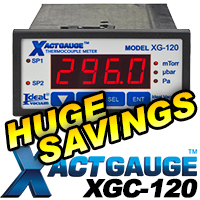
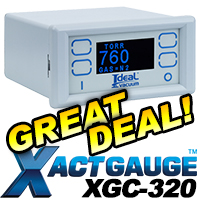

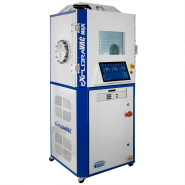



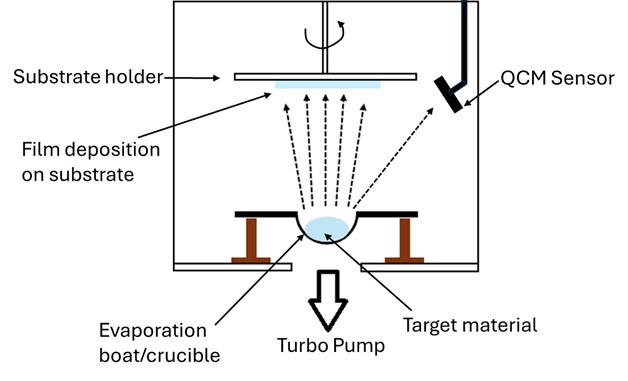
 AlQ3.jpg)
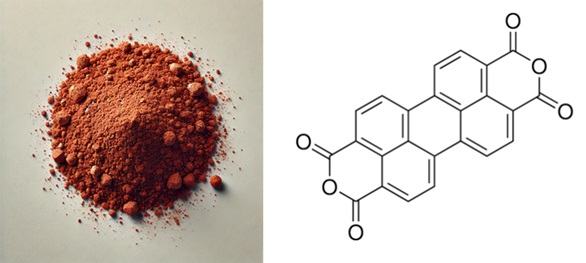

.jpg)
